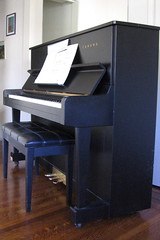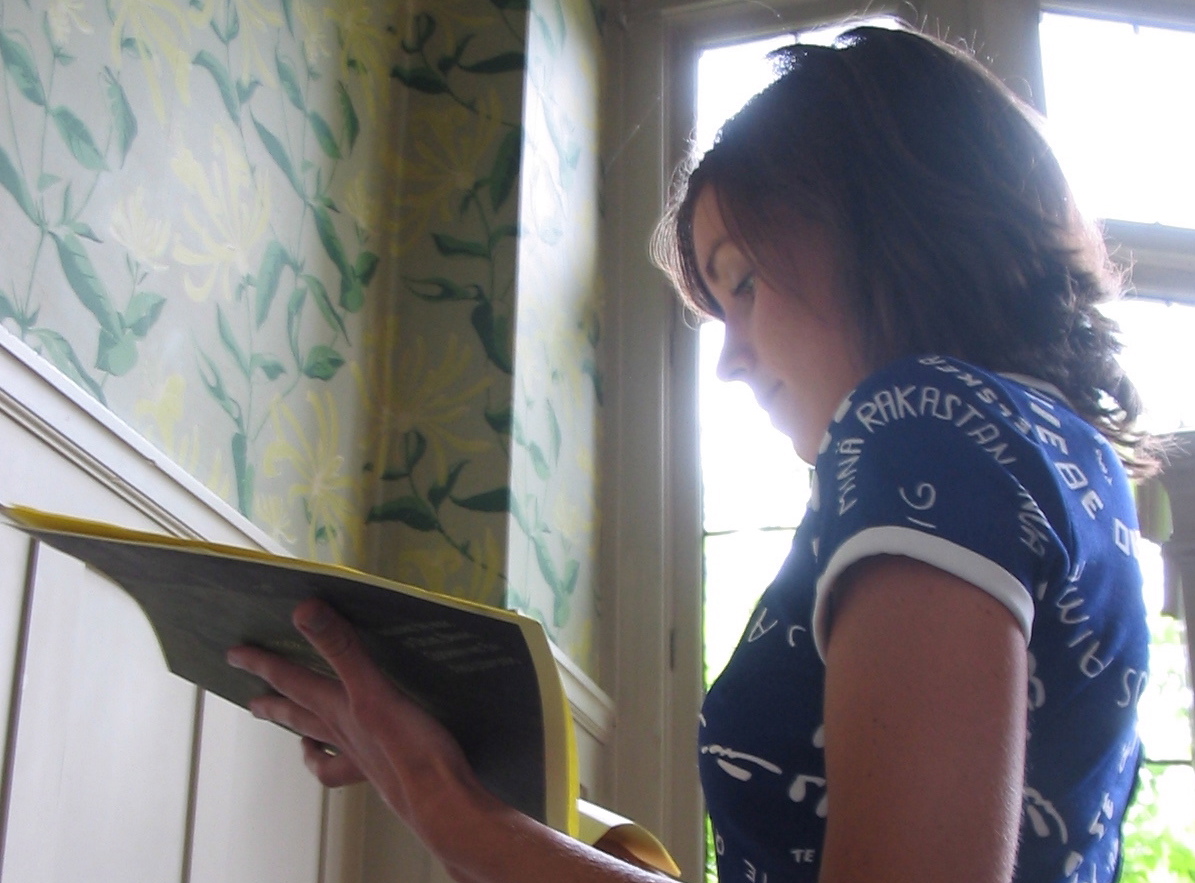Truths (In a Glass of Wine)
It all goes back to the major and minor scales. To really understand the piano, one must know its scales, simple as that.
 Beginning adult piano students pose the question(s) all the time. Do they have to learn scales? Do they have to learn particular fingerings for the scales? Do they have to play hands together? It’s the word "have" that bothers me the most. I’ll lean forward in my teacher chair, elbow perched precariously on top of two crossed knees, and throw the questions right back at them, "But don’t you want to learn these scales, these fingerings, the hands together?" I, of course, benefit from retrospect. The piano teacher who presented me (oh so ceremoniously, when I had just turned thirteen) with her grid-like checklist of scales--the columns consisted of major and minor key names while the rows tracked the metronome settings for quarter, eighth, or sixteenth notes; in parallel or contrary motion; in thirds and sixths, etc.--deserves my first born. That checklist, and its weekly assignments, kept me honest: it demanded daily attention or else. (Or else it shamed me ruthlessly on lesson day.)
Beginning adult piano students pose the question(s) all the time. Do they have to learn scales? Do they have to learn particular fingerings for the scales? Do they have to play hands together? It’s the word "have" that bothers me the most. I’ll lean forward in my teacher chair, elbow perched precariously on top of two crossed knees, and throw the questions right back at them, "But don’t you want to learn these scales, these fingerings, the hands together?" I, of course, benefit from retrospect. The piano teacher who presented me (oh so ceremoniously, when I had just turned thirteen) with her grid-like checklist of scales--the columns consisted of major and minor key names while the rows tracked the metronome settings for quarter, eighth, or sixteenth notes; in parallel or contrary motion; in thirds and sixths, etc.--deserves my first born. That checklist, and its weekly assignments, kept me honest: it demanded daily attention or else. (Or else it shamed me ruthlessly on lesson day.)
Not long after I had immersed myself in a daily scale regimen, my teacher "assigned" me to pencil in the fingering for a Bach prelude. Every note. The following week, she reviewed my fingerings and offered corrections. At first, I did not consciously realize that these assignments were actually an extension of learning the piano scales, but the passages that called for a quick "thumb under" or textbook stepwise ascent were always the ones that I penciled in first. Figuring out fingerings in the repertoire--as derived from the major and minor scales--eventually became an intuitive skill, and even then, I never tired of imagining ways around and through the topography of various keys and their modulations. The g-sharp minor prelude and fugue from book two of Bach’s WTC? What a bitch! Yet trying to think of ways to route my fingers through that terrain as easily as its relative major (B) never fails to entertain my imagination. (Attention, adult beginners! Do you see that a working knowledge of scales is both fun and useful?)
A month ago I resolved, among other things, to make 2006 the year of learning about wine. At what amounted to my first serious "lesson," (a line-up of syrah--three from the Rhône and one from California) a friend suggested, "If you want to understand wine, you must first know and understand the grape." Learning to distinguish one grape from another allows one to raise the glass with a certain expectation, with an informed idea about what it might or might not have to offer. Expectations may be met (or not) and are sometimes even surpassed; weighing those assessments is the fun part of the study, and eventually the responses become more and more intuitive. When I sit down to a piece of music, I bring a developed awareness for the idiomatic patterns, twists, and turns of each particular key. The terrain under my fingers is completely familiar thanks to years of practicing scales; I know what to expect but can also navigate the unexpected fairly well. Understanding wine is, perhaps, no different; it's a subtle study, more subjective, but one that can always return to the fundamental truth, to the grape. The grapes--syrah, pinot noir, or viognier--and the piano scales (G, f, or C-sharp)--are all revelations of truth.
 Forget the rhapsodic, romanticized approach to wine tasting. "I’m not going to tell you what you should be smelling or tasting--what’s important are your own opinions, whatever those may be." Such methods are as amusing as a beginning student who waves aside the fingering chart, "I’ve come up with my own fingering for this scale, so that I don’t have to cross my thumb at all." Why reinvent the wheel when concrete truths exist? These are the fixed guidelines from which to measure (and sometimes laugh at) our own opinions and strategies. There must be wine instructors as thorough and methodical as my childhood piano teacher. We all deserve as much.
Forget the rhapsodic, romanticized approach to wine tasting. "I’m not going to tell you what you should be smelling or tasting--what’s important are your own opinions, whatever those may be." Such methods are as amusing as a beginning student who waves aside the fingering chart, "I’ve come up with my own fingering for this scale, so that I don’t have to cross my thumb at all." Why reinvent the wheel when concrete truths exist? These are the fixed guidelines from which to measure (and sometimes laugh at) our own opinions and strategies. There must be wine instructors as thorough and methodical as my childhood piano teacher. We all deserve as much.
continue reading...
 Beginning adult piano students pose the question(s) all the time. Do they have to learn scales? Do they have to learn particular fingerings for the scales? Do they have to play hands together? It’s the word "have" that bothers me the most. I’ll lean forward in my teacher chair, elbow perched precariously on top of two crossed knees, and throw the questions right back at them, "But don’t you want to learn these scales, these fingerings, the hands together?" I, of course, benefit from retrospect. The piano teacher who presented me (oh so ceremoniously, when I had just turned thirteen) with her grid-like checklist of scales--the columns consisted of major and minor key names while the rows tracked the metronome settings for quarter, eighth, or sixteenth notes; in parallel or contrary motion; in thirds and sixths, etc.--deserves my first born. That checklist, and its weekly assignments, kept me honest: it demanded daily attention or else. (Or else it shamed me ruthlessly on lesson day.)
Beginning adult piano students pose the question(s) all the time. Do they have to learn scales? Do they have to learn particular fingerings for the scales? Do they have to play hands together? It’s the word "have" that bothers me the most. I’ll lean forward in my teacher chair, elbow perched precariously on top of two crossed knees, and throw the questions right back at them, "But don’t you want to learn these scales, these fingerings, the hands together?" I, of course, benefit from retrospect. The piano teacher who presented me (oh so ceremoniously, when I had just turned thirteen) with her grid-like checklist of scales--the columns consisted of major and minor key names while the rows tracked the metronome settings for quarter, eighth, or sixteenth notes; in parallel or contrary motion; in thirds and sixths, etc.--deserves my first born. That checklist, and its weekly assignments, kept me honest: it demanded daily attention or else. (Or else it shamed me ruthlessly on lesson day.)Not long after I had immersed myself in a daily scale regimen, my teacher "assigned" me to pencil in the fingering for a Bach prelude. Every note. The following week, she reviewed my fingerings and offered corrections. At first, I did not consciously realize that these assignments were actually an extension of learning the piano scales, but the passages that called for a quick "thumb under" or textbook stepwise ascent were always the ones that I penciled in first. Figuring out fingerings in the repertoire--as derived from the major and minor scales--eventually became an intuitive skill, and even then, I never tired of imagining ways around and through the topography of various keys and their modulations. The g-sharp minor prelude and fugue from book two of Bach’s WTC? What a bitch! Yet trying to think of ways to route my fingers through that terrain as easily as its relative major (B) never fails to entertain my imagination. (Attention, adult beginners! Do you see that a working knowledge of scales is both fun and useful?)
A month ago I resolved, among other things, to make 2006 the year of learning about wine. At what amounted to my first serious "lesson," (a line-up of syrah--three from the Rhône and one from California) a friend suggested, "If you want to understand wine, you must first know and understand the grape." Learning to distinguish one grape from another allows one to raise the glass with a certain expectation, with an informed idea about what it might or might not have to offer. Expectations may be met (or not) and are sometimes even surpassed; weighing those assessments is the fun part of the study, and eventually the responses become more and more intuitive. When I sit down to a piece of music, I bring a developed awareness for the idiomatic patterns, twists, and turns of each particular key. The terrain under my fingers is completely familiar thanks to years of practicing scales; I know what to expect but can also navigate the unexpected fairly well. Understanding wine is, perhaps, no different; it's a subtle study, more subjective, but one that can always return to the fundamental truth, to the grape. The grapes--syrah, pinot noir, or viognier--and the piano scales (G, f, or C-sharp)--are all revelations of truth.
 Forget the rhapsodic, romanticized approach to wine tasting. "I’m not going to tell you what you should be smelling or tasting--what’s important are your own opinions, whatever those may be." Such methods are as amusing as a beginning student who waves aside the fingering chart, "I’ve come up with my own fingering for this scale, so that I don’t have to cross my thumb at all." Why reinvent the wheel when concrete truths exist? These are the fixed guidelines from which to measure (and sometimes laugh at) our own opinions and strategies. There must be wine instructors as thorough and methodical as my childhood piano teacher. We all deserve as much.
Forget the rhapsodic, romanticized approach to wine tasting. "I’m not going to tell you what you should be smelling or tasting--what’s important are your own opinions, whatever those may be." Such methods are as amusing as a beginning student who waves aside the fingering chart, "I’ve come up with my own fingering for this scale, so that I don’t have to cross my thumb at all." Why reinvent the wheel when concrete truths exist? These are the fixed guidelines from which to measure (and sometimes laugh at) our own opinions and strategies. There must be wine instructors as thorough and methodical as my childhood piano teacher. We all deserve as much.continue reading...

 In "Alternating Thirds," for example, the pianist must master the trick of playing the entire piece, a
In "Alternating Thirds," for example, the pianist must master the trick of playing the entire piece, a  Bartok, like Debussy, is not satisfied to fade away into the stratosphere and so punctuates the piece with that low E, a soft punch that clarifies the e
Bartok, like Debussy, is not satisfied to fade away into the stratosphere and so punctuates the piece with that low E, a soft punch that clarifies the e 


